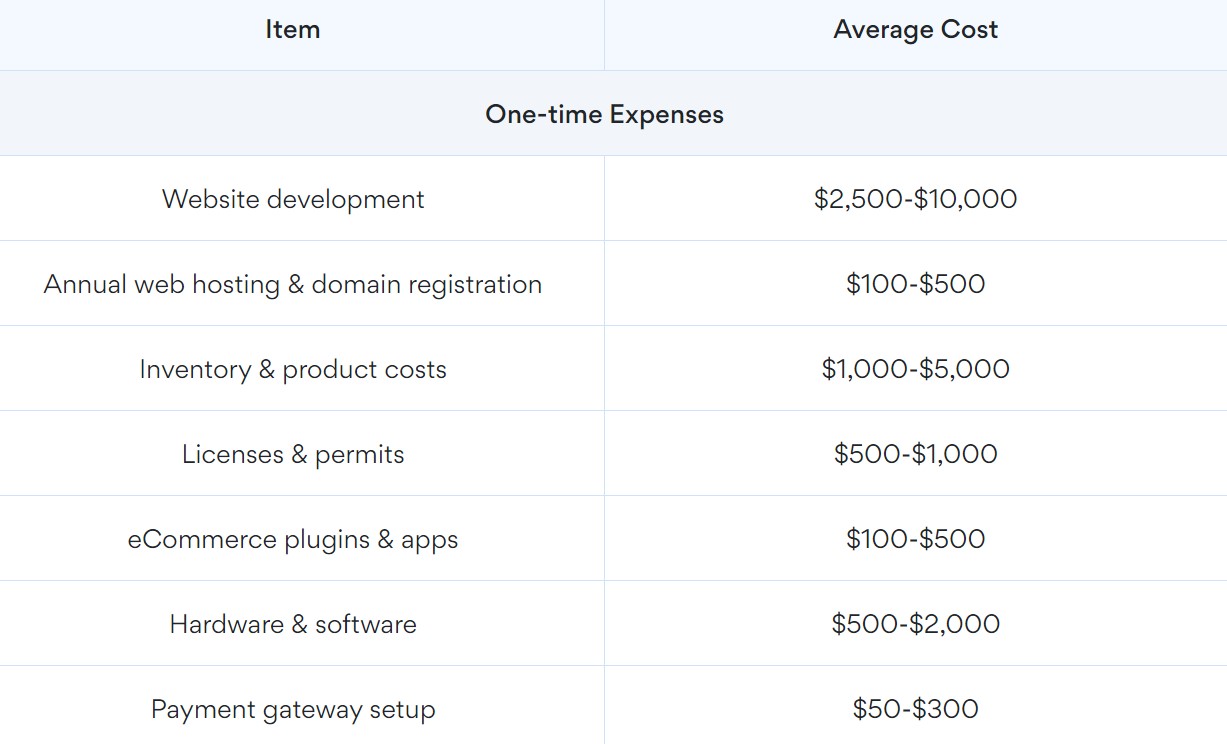Starting a retail business from scratch takes time and effort. With retail giants like Amazon and eBay dominating the market, it becomes even more difficult to grab market share.
The costs of starting an ecommerce business are high. In fact, website development alone can cost $2,500 to $10,000. The image below shows the top costs of starting an ecommerce business.

Image via Upmetrics
This poses two challenges:
- It raises the barrier to entry in the ecommerce industry.
- If a business fails, losses are substantial.
That’s where connective ecommerce comes into the picture. It aims to solve these problems by lowering entry costs and making it easier for anyone to start an ecommerce business.
In this post, we’ll explore the various benefits and challenges of connective ecommerce.
But first, let’s understand what connective ecommerce is and why it matters.
What is connective ecommerce?
Connective ecommerce is an emerging concept with the potential to revolutionize online retail. It is a cost-effective way of starting an ecommerce business and cost-effectively streamlining operations.
It streamlines three core areas of online selling:
- Website development: It eliminates the need to hire a developer and encourages the use of free website builders to save on web development costs. You can build your eshop website yourself using predesigned templates.
- Inventory management: Connective ecommerce involves advanced concepts like dropshipping, where the retailer doesn’t need to store inventory or fulfill orders.
- Advertising and marketing: It encourages retailers to use social media promotion and other cost-effective connective marketing tactics.
Why is it the future of online shopping?
Connective ecommerce is changing the operational dynamics of online retail businesses.
Here are some ways in which it will revolutionize online retail:
- Lower startup costs: It considerably reduces the initial costs of starting an ecommerce business. This makes it easier for new entrepreneurs to start an online business without much risk.
- Streamlined operations: By outsourcing order fulfillment and inventory management, connective ecommerce makes operations lean. Retailers only need to focus on sales, and suppliers will handle the logistics.
- Reduced time to market: Website builders like Wix, Shopify, and Magento provide ready-to-use templates that allow you to create an eshop website quickly. Also, since order fulfillment is outsourced, entrepreneurs can start a new business much faster.
Connective ecommerce strategy
Here’s an easy guide to creating a connective ecommerce strategy for your business.
Choosing the right service provider
Several service providers, like Wix, Shopify, and BigCommerce, offer ecommerce solutions. Consider the following when selecting a service provider:
- Experience and expertise
- Features and functionality of the platform
- Cost and pricing model
- Security and compliance
- Reputation and reviews
Planning and implementing components integration
Integrations play an important role in building an all-inclusive ecommerce business. The more tools you can integrate with your ecommerce store, the better customer experience you can deliver.
Here are some types of tools you should integrate within your ecommerce ecosystem:
- Product listings
- Payment gateways
- Inventory management systems
- Marketing tools
- Customer relationship management systems (CRM)
Testing the website and establishing a troubleshooting plan
Before launching your ecommerce store, test your eshop website for problems, such as broken links, browser compatibility issues, and mobile unresponsiveness.
- Ensure all website functionalities are working. Test product browsing, add items to your cart, and try the checkout process.
- Ensure consistent functionality across various browsers. Test your website on Chrome, Firefox, and Safari browsers.
- Verify that your website is responsive on various mobile devices.
- Establish a reliable troubleshooting strategy to resolve problems after your website’s launch.
Partnering with third-party suppliers
Connective ecommerce involves working with third-party suppliers. They perform different services like dropshipping, managing inventory, and fulfilling orders.
Choose a supplier that:
- Offers high-quality products (this is vital for customer satisfaction)
- Delivers products promptly
- Provides efficient customer service
- Communicates effectively and promptly addresses issues
- Has no hidden costs (clearly understand the supplier’s costs and negotiate pricing)
Promoting products on social media
Use social media platforms like Facebook, Instagram, Twitter, and TikTok to promote your business organically and generate leads. Here are some tips to get you started:
- Create relevant and engaging content and distribute it.
- Tailor your message and leverage social selling by engaging with potential customers. Also, respond promptly and engage in relevant discussions.
- Utilize social commerce features that allow you to sell on social media. For example, shoppable posts and live shopping videos.
Benefits of connective ecommerce
In this section, we’ll take you through some key benefits of using the connective ecommerce approach.
Affordability and efficiency
Connective ecommerce is a cost-effective online business model. Most connective ecommerce platforms require minimal upfront investment and help you outsource logistics and order fulfillment. You can also cut warehousing, inventory management, and shipping costs.
Easy setup
Getting started on most connective ecommerce platforms and tools is straightforward. Establishing an online retail store doesn’t require any specialized technical expertise.
Website builders like Wix offer user-friendly interfaces and drag-and-drop functionalities to make building a website seem like a breeze.
They provide customizable pre-built templates, so you don’t need to build your store from scratch. Platforms like Shopify provide detailed guides to navigate any problems you may encounter.
No need to manage physical inventory
Connective ecommerce encourages retailers to partner with third-party suppliers to store inventory and ship products. This eliminates the need to stock items physically. It also minimizes overhead costs for inventory management.
Improved customer experience
A seamless customer experience can help you attract repeat business. Adopting connective ecommerce allows for a smooth and enjoyable customer experience.
Connective ecommerce helps your business in the following ways:
- Offers product tracking and personalized recommendations. It helps improve your customers’ shopping experience.
- Some platforms also offer customer relationship management tools. For example, live chat support is excellent for customer service.
Challenges of connective ecommerce
Connective ecommerce offers many solutions for online retailers. It also presents a unique set of challenges. Let’s explore some of them.
Competition with businesses with larger budgets
Smaller ecommerce businesses may struggle to compete with established ones. Competitors with larger budgets use advanced technologies. This gives them an advantage in marketing, branding, and data analytics.
However, small businesses aren’t at a complete disadvantage. They can use cost-effective marketing strategies, such as social media promotion, to achieve their marketing objectives.
Always finding creative solutions for long-term success in the market
Staying relevant in the ecommerce retail market can be challenging. Technological changes, emerging trends, and changing customer preferences can be overwhelming.
When running a small business, you need to be creative and agile to overcome these challenges.
Being sure about suppliers
A wrong supplier can cause shipping delays, low-quality products, and a poor customer experience.
Unsatisfied customers may migrate to competitors or damage your brand’s reputation by sharing negative experiences online.
To avoid this, research and vet suppliers before committing to any partnership.
Integrating and securing data
Connective ecommerce incorporates third-party suppliers, marketing tools, and payment gateways. Managing data from various systems and not limiting user access could result in errors and security concerns.
For instance, sharing sensitive customer data with third-party suppliers can cause breaches. Private data, like addresses and credit card information, can get into the wrong hands.
To avoid this, prioritize data security through encryption, regular audits, and staff training.
Connective ecommerce: Wrap up
Connective ecommerce is more than “a get-rich-quick scheme.” The time and energy needed are like traditional retail business models, just with less initial financial investment.
The points suggested above can serve as food for thought about launching your business. To achieve ongoing success, staying updated with an ever-changing industry is crucial.
